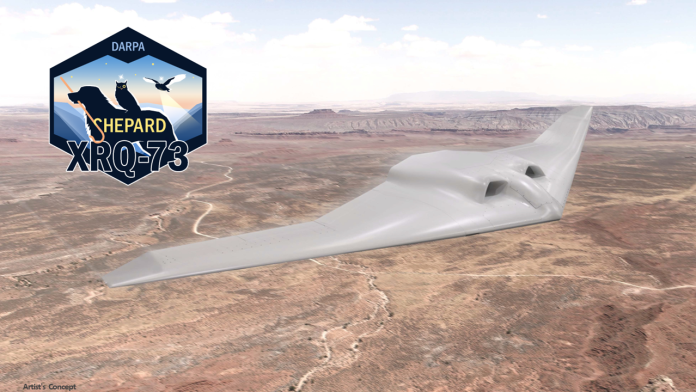This post is also available in:
 עברית (Hebrew)
עברית (Hebrew)
DARPA has officially revealed XRQ-73, its latest stealth fixed-wing drone developed for an “urgent operational need” and set to be operational as soon as possible.
This drone is the next phase in a long line of development of DARPA’s ultra-quiet, high-efficiency XRQ-72A drone, and is being developed under DARPA’s Series Hybrid Electric Propulsion Aircraft Demonstration (SHEPARD) program.
A rendering of the drone that was recently released has some interesting features, including its tailless flying wing design, the lack of the XRQ-72A’s four external nacelle engines. Another feature is a pair of air intakes at the “front” of the drone, a development on earlier designs that showed four instead of two intakes.
Apart from the fact that it features a hybrid-electric propulsion system, there are no further details about the XRQ-73’s power source. Hybrid electric propulsion systems combine fuel-powered engines and motors, offering improved fuel economy and other benefits, while the addition of batteries further allows for operation in a quieter all-electric mode.
According to Interesting Engineering, the intended role of the new drone is currently undisclosed. However, the “RQ” designation suggests it is intended as an ISR platform. The drone’s previous version, the XRQ-72A, was designed for covert surveillance in denied areas, focusing on stealth and ultra-quiet, with the goal of creating a drone capable of persistent operation over extended ranges with a significantly reduced acoustic and infrared signature.
SHEPARD program manager Steve Komadina explained that the idea is to take emerging technologies and burn down system-level integration risks to quickly reach a new long endurance mission aircraft design that can be fielded quickly. “The SHEPARD program is maturing a specific propulsion architecture and power class as an exemplar of potential benefits for the Department of Defense,” he added.
DARPA explains that the XRQ-73 aircraft will be a Group 3 UAS weighing approximately 567 kg, and its first flight is expected by the end of 2024.

























